|
Thursday, April 27 – Rabat
After breakfast, Nour leads the orientation meeting and then we meet Ali, our city guide. He’s a sweet, sharp guy who shows us Rabat.
Stop #1 – Royal Palace is surrounded by attractive diplomatic and residential buildings in a relatively small but attractive compound. There are some 20 plus royal palaces all over Morocco. This one, in Rabat, boasts of a lovely gate, which you cannot enter. You must stand at a distance from the palace and strain to see the guards checking out the diplomatic officials entering and leaving. Ali points out the special hooded messengers who hand deliver official documents the old fashioned way – in person, not electronically. Ali also tells us there’s a golf course inside the wall. We are left with only our imaginations and telephoto lenses to try and capture what goes on within the palace grounds.
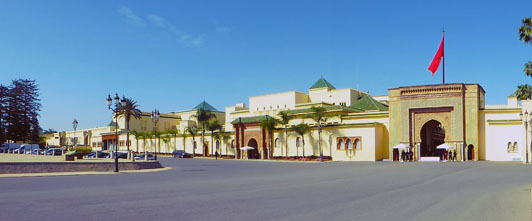
Rabat Royal Palace |
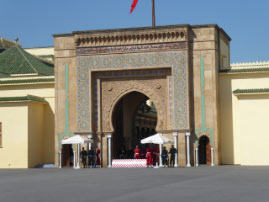
Rabat Royal Palace |
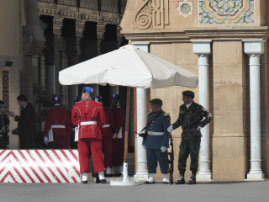
Rabat Royal Palace |
Stop #2 – Bab ar-Rouah (Gate of the Winds)
On our way to visit the Roman Ruins of Kasbah Chellah, we pass through the Gate of Winds, because it is constantly being battered by coastal winds. We are greeted at the entrance by an energetic man dancing to some traditional Moroccan / African music hoping around (and hopping) for a tip.
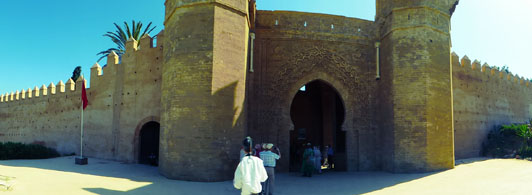
Bab ar-Rouah (Gate of the Winds) |
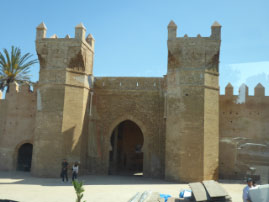
Bab ar-Rouah (Gate of the Winds) |
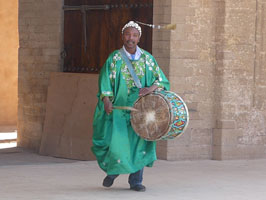
Man dancing around |
Stop #3 – The old ruins of Chellah, UNESCO Heritage Sites, contains both Roman ruins dating back to 3-4th Century AD and Islamic ruins that were added later from the 13-14th Century.
Ali takes us down a garden path which ends at the ancient Roman City with the remnants of its marketplace, columns, ancient baths and other crumbling dwellings. The city sits within the giant surrounding walls. Today’s only inhabitants are the resident storks – and lots of them.
Islam took over the neighborhood in the 13th century. In 1339, Abou Yacoub Youssef built a mosque and burial place for his wife, then the site became the burial place for the Merinid rulers. There are now at least 50 tombs.
I really like exploring this enchanted place.
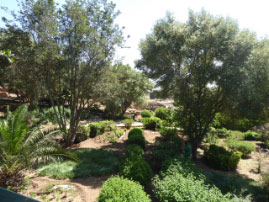
Chellah |
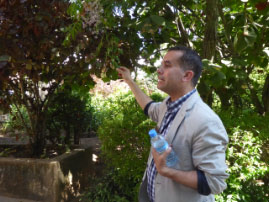
Chellah |
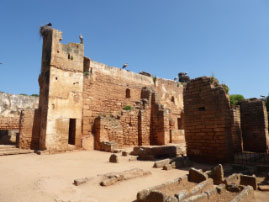
Chellah |
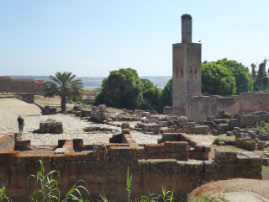
Chellah |
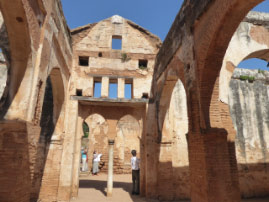
Chellah |
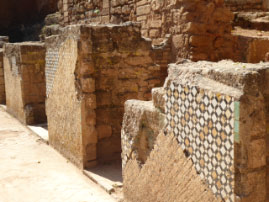
Chellah |
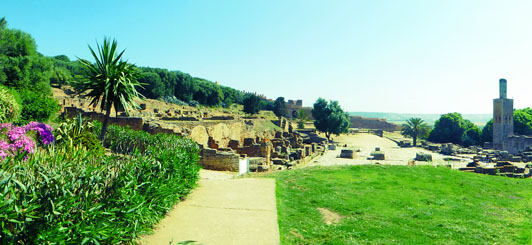
Chellah |
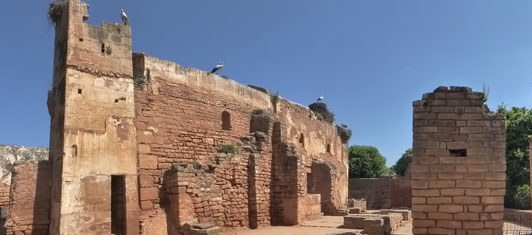
Chellah |
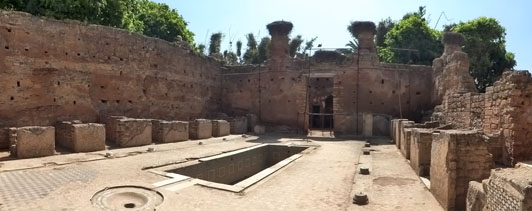
Chellah |
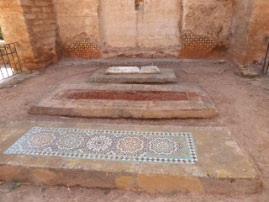
Chellah |
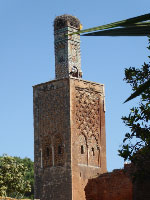
Chellah | 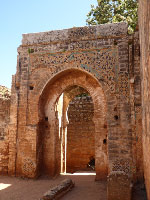
Chellah |
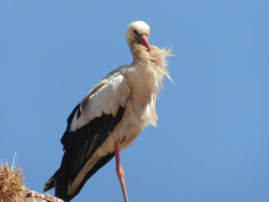
Chellah |
Stop #4 – The Mausoleum of Mohammed the 5th / Hassan Tower (unfinished mosque)
Before we enter the complex, we stop to pose with a guard who seems a bit annoyed. The area, including the tower, the tomb and the ancient Roman columns is clean, and breezy with wonderful panoramic photo opportunities.
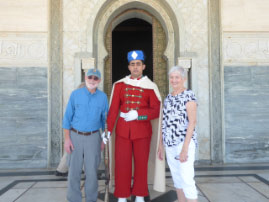
Hassan Tower |
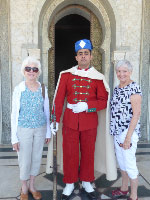
Hassan Tower |
Construction of the Hassan Mosque began in 1195 during the Almohad Dynasty. The then Sultan had big dreams that this mosque would be the largest in the world. But as fate would have it, the sultan passed away and work on the project came to an end, leaving the mosque unfinished, and its minaret – the tower – standing only 44 meters high (some say half as high as the Sultan would have wanted). Then came the 1755 Lisbon earthquake that further destroyed the mosque. Still standing today is the one surviving, sandstone Hassan Tower, along with the mosque’s remains and the Roman columns and walls.
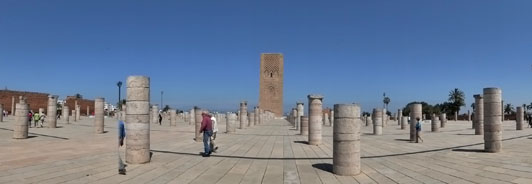
Hassan Mosque |
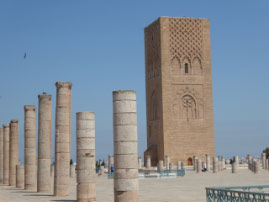
Hassan Mosque |
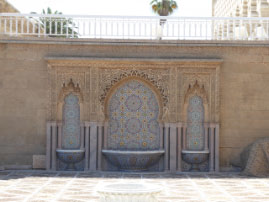
Hassan Mosque |
Across from the Hassan Tower is a magnificent white marble mausoleum commissioned by King Hassan II in 1962 for his father, Mohammed V. The tomb, completed in 1971, is the final resting place for Mohammed V and his two sons, King Hassan II (the guy who commissioned the mausoleum) and Prince Abdallah. Mohammed V, sultan of Morocco for two periods - 1927 to 1953 and 1957 to 1961, is credited for helping Morocco gain its independence.
Inside, the mausoleum is lavishly decorated with ceilings that absolutely knock your socks off.
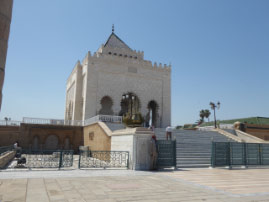
Hassan Mosque |
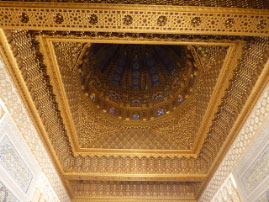
Hassan Mosque |
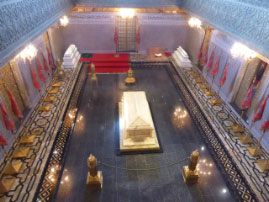
Hassan Mosque |
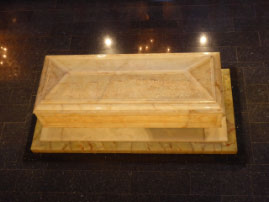
Hassan Mosque |
Stop #5 – Kasbah of the Oudaya
The fortress was built in the 12th century overlooking the Bouregreg River. It later became the refuge of Andalusian Muslims fleeing Spain in the early 1600s, expanding with its increasing population.
We enter through an upper gate and then meander through cobble-stone streets and narrow passageways. The place is charming lined with houses, cafes and shops, all decked out in blue and white paint.
Memory Jogger Note: Nour bought us some candy from a street vendor that almost broke my tooth.
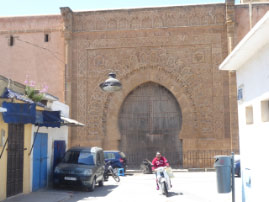
Kasbah of the Oudaya |
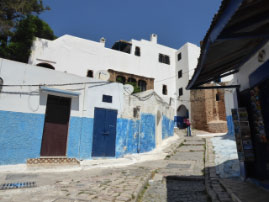
Kasbah of the Oudaya |
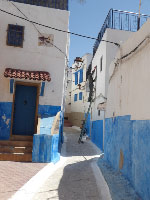
Kasbah of the Oudaya |
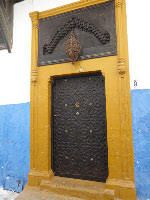
Kasbah of the Oudaya |
We wind our way up to the very to end where we have tea on an open terrace with breath taking views overlooking the water. I feel as though I’m transported to some Greek Island -- absolutely beautiful. Rabat is a very stylish city – so it’s not surprising that its kasbah is very classy.
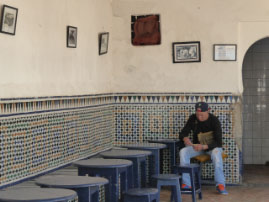
Kasbah of the Oudaya |
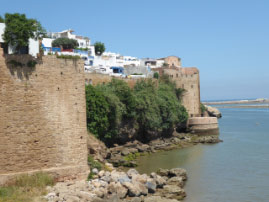
Kasbah of the Oudaya |
Nour leads us back via the Andalusian Gardens, designed by two French guys for the whole town to enjoy. I didn’t go ga-ga over the gardens, maybe because the arrangements and the design of the garden are just so-so and most of the plants are so southern Californian. Sorry, can’t get excited over bougainvilleas anymore. We leave through another main gate and walk back to the bus.
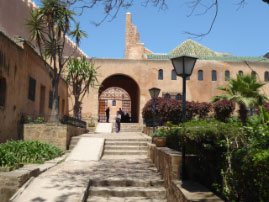
Andalusian Gardens |
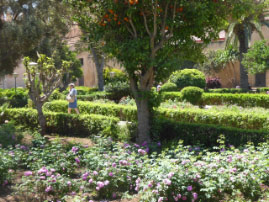
Andalusian Gardens |
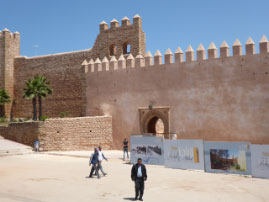
Town Wall |
The bus drives up a hill to “16 November Square” overlooking the town of Sale. The square established by King Mohammd VI in 2005, commemorates Morocco’s 1956 Independence from France. A bicameral legislature was established in 1997, although the King still possesses the actual political power.
The bus drops us off for lunch. After lunch we join Rex, Kathy and Margurita and walk to the Anthropology Museum. It’s very simple and nicely done and gives you a great snapshot of how all the cultures mixed together. There a lot of good marble and bronze sculptures, but without any English translations, so we do a lot of guesswork. Around 80 per cent of the artifacts are from Roman sites in Morocco, predominantly Volubilis – a fabulous ancient town that we visit later in the trip.
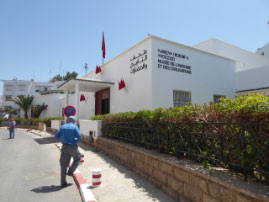
Anthropology Museum |
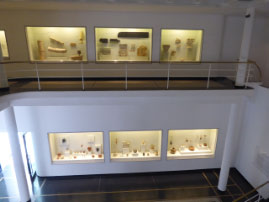
Anthropology Museum |
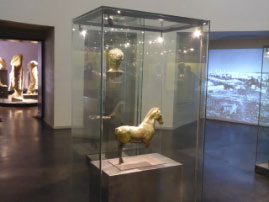
Anthropology Museum |
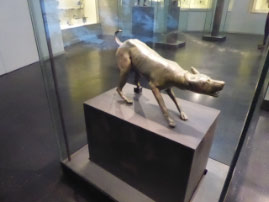
Anthropology Museum |
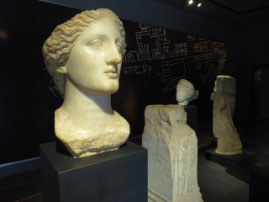
Anthropology Museum |
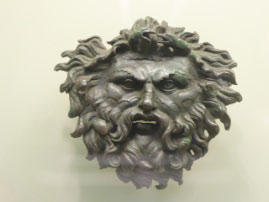
Anthropology Museum |

Anthropology Museum |
We join the group to take the bus to a liquor store to stock up for a wild time in the Sahara Desert.
For dinner, we go to the medina where we meet a hooded guy with a light who takes us to his restaurant – beautiful, eye popping place with delightful food and music. Of course, Nour loves to serenade us. After our dining experience, our tummies are full and our hearts are happy as the cute little guy with the lantern escorts us down the hill and back to the bus. (Remember Dinarjak in Rabat Media – highly recommended by me!)
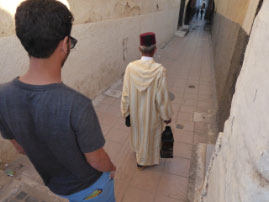
Going to dinner |
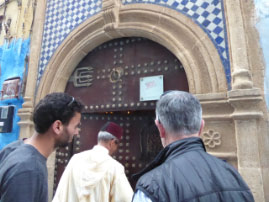
Going to dinner |
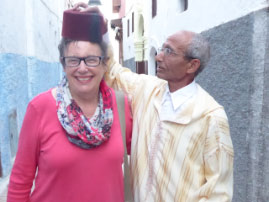
Going to dinner |
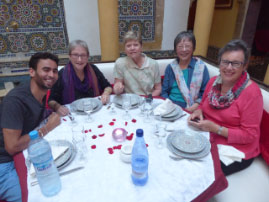
Dinner |
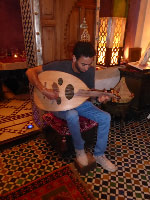
Nour serenading us |
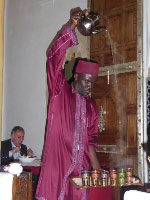
Dinarjak in Rabat Media |
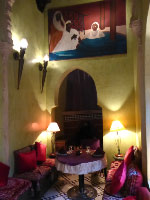
Dinarjak in Rabat Media |
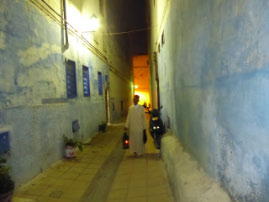
Heading home |
We arrive back to the hotel about 9:30. I make the mistake of turning on the tv only to be further sickened by Trump and his cast of clowns – Kellyann, Spicy, etc. who make me very sad for my country.
Friday, April 28 – Fez
After a nice breakfast, we get on the bus and head for the city of Fez. It’s a beautiful drive through the rolling countryside and then the tree covered slopes of Mount Zerhoun which mark the beginning of the Rif Mountains. Nour tells us stories about his boyhood as a Berber boy growing up in the Rif Mountains. He was a clever boy and learned English (and other languages) by guiding tourists through the mountains. He became a musician when his English teacher used songs to teach him English. We love hearing his stories and his music.
We stop in a town for coffee. I order a special coffee called nous nous – a favorite in Morocco. Then we check out a local market.
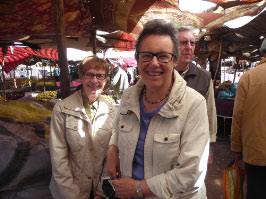
Local Market |
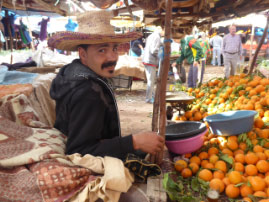
Local Market |
We arrive in Fez about noon. The porters unload our luggage from the bus and we walk up the hill to the Riad Salam -- once a grand palace and is now beautifully refurbished into a guesthouse. All the woodwork is hand crafted. I love being a rich lady today. We have a nice lunch and then I settle into our room to catch up on my journal. The room is lovely and the rain outside makes it even more cozy.
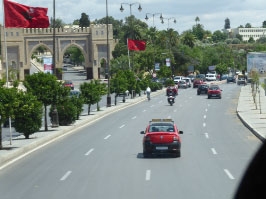
Arriving in Fez |
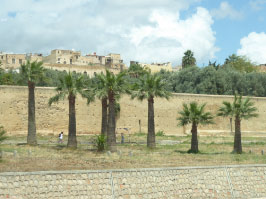
Fez |
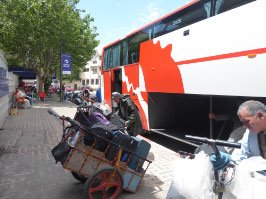
Arriving Riad Salam |
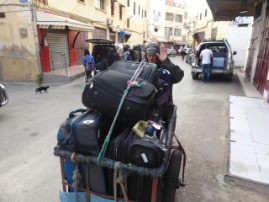
Arriving Riad Salam |
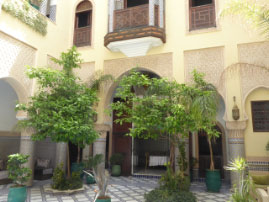
Riad Salam |
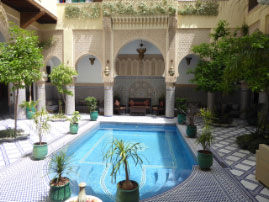
Riad Salam |
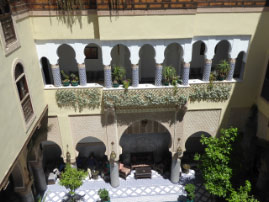
Riad Salam |
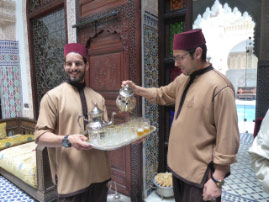
Riad Salam |
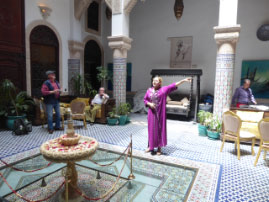
Riad Salam |
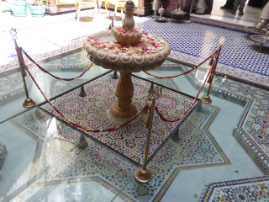
Riad Salam |
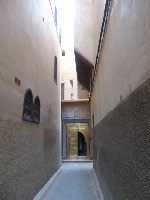
Riad Salam |
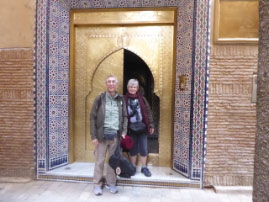
Riad Salam |
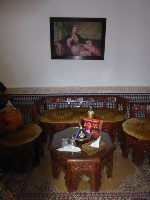
Riad Salam |
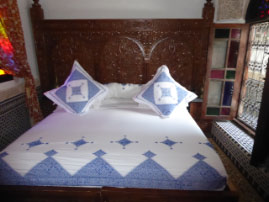
Riad Salam |
At 4 pm, we meet our guide and take a short drive up a hillside for a panoramic view of Fez’s Old City, also known as the medina. Founded by Idris I in 789, Fez is the second largest city of Morocco, with a population of 1.1 million. Fez was the capital city of modern Morocco until 1925. The view is wonderful. Our guide offers to take group photos. He knows nothing about cameras and takes the worst group photo ever – judge for yourself.
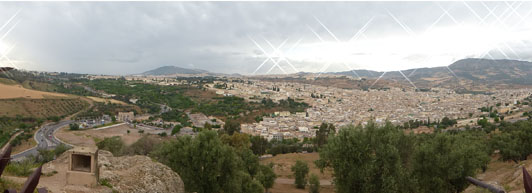
Fez |
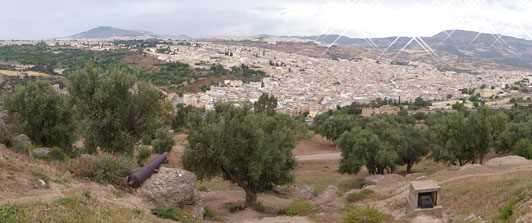
Fez |
We stop at a very old local Moroccan pottery shop. We see the kiln where the pots are fired. The guide asks if we know what material is used to flame the pots for making tagines (clay cooking pots). Joan guesses olive pits and is right. She’s so smart. The rest of the presentation was pretty dull. I am not tempted to buy anything so I take a few photos and call it a day.
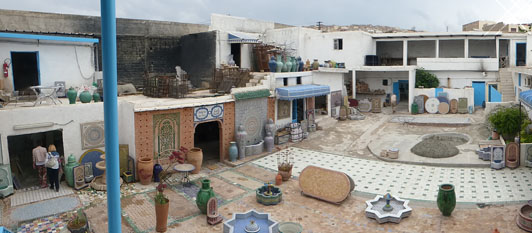
Pottery Shop |
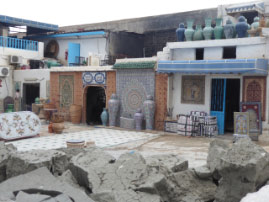
Pottery Shop |
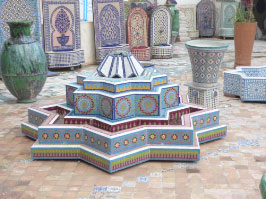
Pottery Shop |
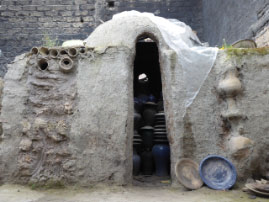
Pottery Shop |
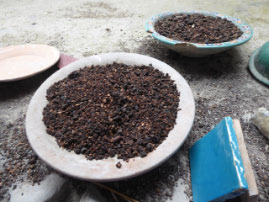
Pottery Shop |
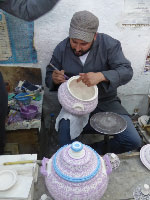
Pottery Shop |
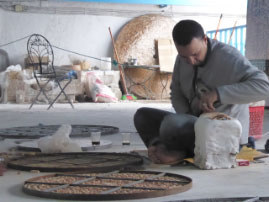
Pottery Shop |
We dine at our riad / palace -- service and food excellent. However, there is an incident when a fellow traveler goes ballistic after his bottle of wine is kicked over by the waiter. I wish that hadn’t happened.
Saturday, April 29 – Fez
We have a lovely breakfast at the riad and then off for a full day of sightseeing with the local guide. Although he can’t take photos worth a damn, he is an extremely intelligent, sweet man with lots of information to share. He seemed to know and embrace everyone along the way.
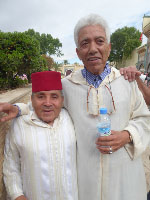
Local Guide in Fez |
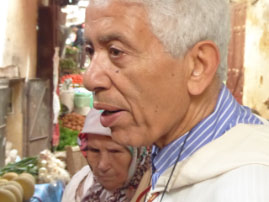
Local Guide in Fez |
Our task for the day is to cover Fez – a huge job. The Fez medina is an UNESCO World Heritage Site and the most well preserved city dating back to the medieval times. Built in the 9th century, the medina is a myriad of tiny lanes – or about 10,000 alleys, that are too narrow for cars so Fez is a car fee. It’s easy to get lost in the alleyways among the numerous cafes, bazaars and small shops selling all kinds of hand-made products: everything from clothes and jewelry to furniture and food. The only means of transporting goods inside the medina are mules or small carts with the occasional motorcycle zooming through the crowed lanes.
We enter one of the main gates to Fez and make our first stop at the elegant gates of the Royal Palace where, of course, we pose with the guards. (I’m sure they love it!)
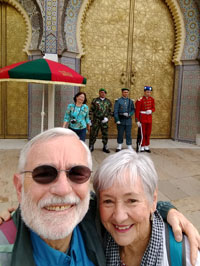
Fez medina |
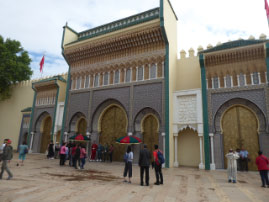
Fez Medina |
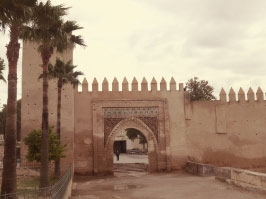
Main Gates of Fez |
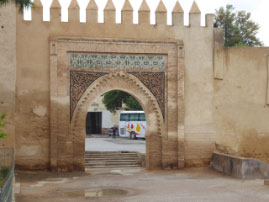
Main Gates of Fez |
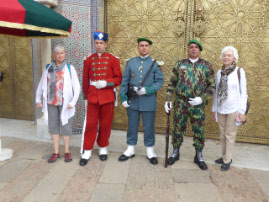
Fez Medina |
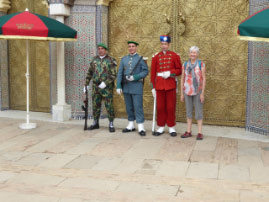
Fez Medina |
We explore the mellah – the Jewish quarter. Up to 250,000 Jews once lived here dating back to the 14th century. Since the formation of Israel in 1948, most of the Jewish population left for Israel, with only a very few Jews living in the area today. The Jewish Quarter is known for its balconies and architecture. The Jewish houses have balconies are on the exterior as opposed to the Muslims have closed balconies.
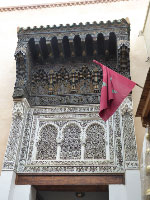
Fez medina |
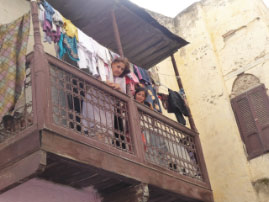
Fez medina |
There are no functioning synagogues in the Jewish quarter today. However, we visit one small synagogue that houses the Tora and other Jewish artifacts. With help from UNESCO, it is being restored. We explore the ancient building and climb to the top floor to get a view of the Jewish cemetery.
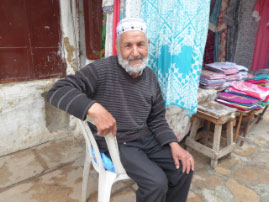
Jewish quarter |
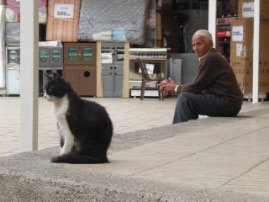
Jewish quarter |
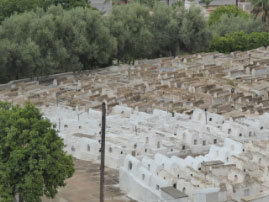
Jewish quarter |
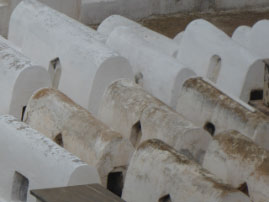
Jewish quarter |
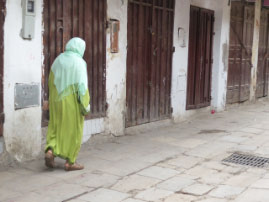
Jewish quarter |
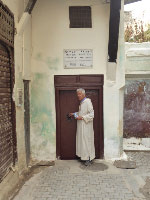
Jewish quarter |
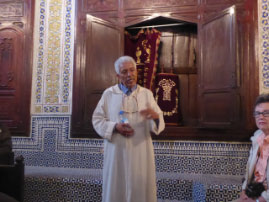
Jewish quarter |
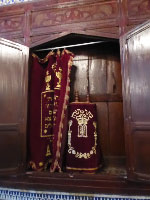
Jewish quarter |
Outside the old synagogue, life goes on -- children are playing soccer and a friendly local is down on his luck. I give him a few dirhams and he poses nicely for my picture. We continue our walk through the souks (markets) of Fez – trying to stay with the group and NOT GET LOST! The scenes are a feast for the eyes.
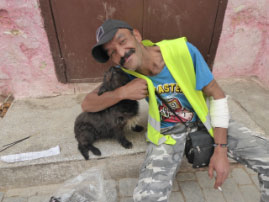
Jewish quarter |
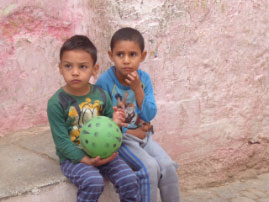
Jewish quarter |
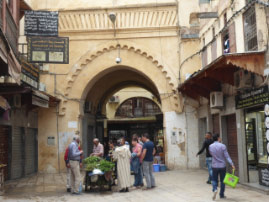
Fez Medina |
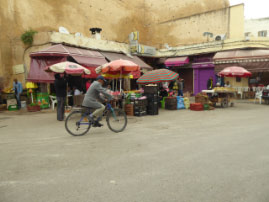
Fez Medina |
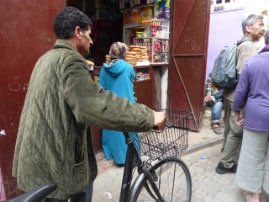
Fez Medina |
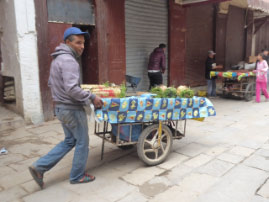
Fez Medina |
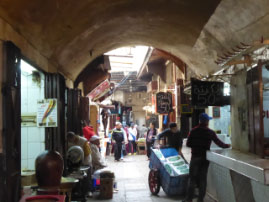
Fez Medina |
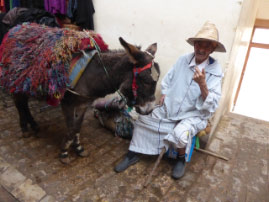
Fez Medina |
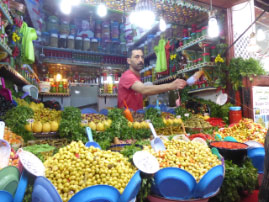
Fez Medina |
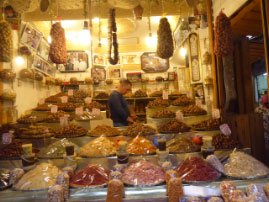
Fez Medina |
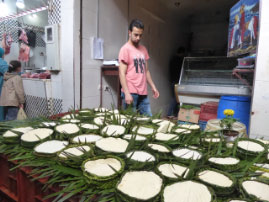
Fez Medina |
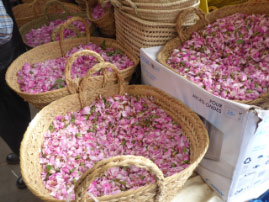
Fez Medina |
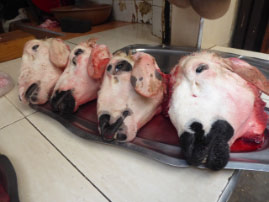
Fez Medina |
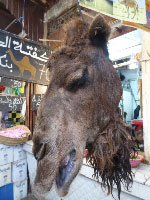
Fez Medina |
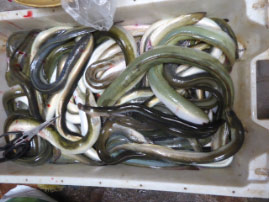
Fez Medina |
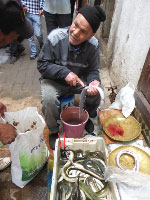
Fez Medina |
We wind our way to an open area alive with activity. A couple of guys are making music and dancing with such abandonment and joy. They know the more joy, the more dirhams. To add to the noise level, there are clusters of artisans banging away on pieces of copper and tin, turning it into “must have” souvenirs.
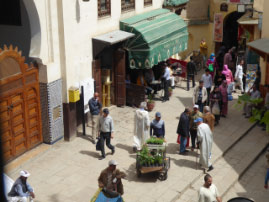
Fez Medina |
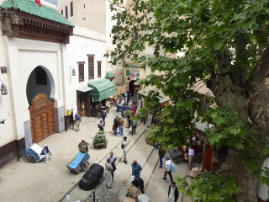
Fez Medina |
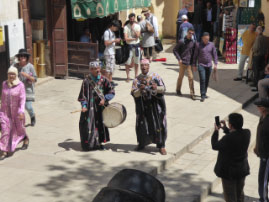
Fez Medina |
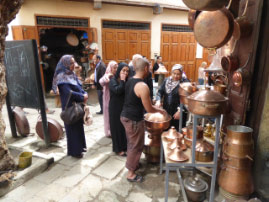
Fez Medina |
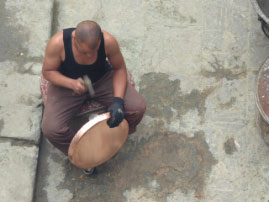
Fez Medina |
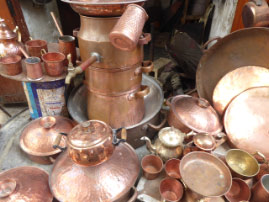
Fez Medina |
We climb to a 3rd floor coffee shop overlooking the beautiful vistas of Fez. We also have a great view of the activity on the square below. We try to enjoy our nous nous in peace, but with all that pounding and tapping below, we thought we’d lose our minds.
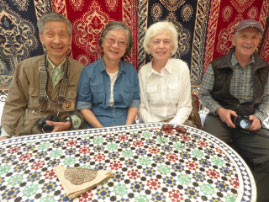
Fez Medina |
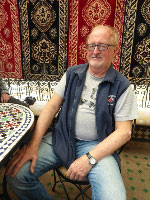
Fez Medina |
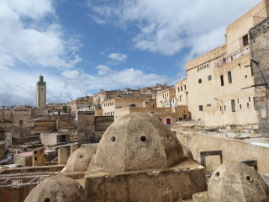
Fez Medina |
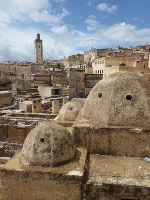
Fez Medina |
Before lunch we pass by several mosques. Fez has more than 400 mosques and more than half of these mosques are inside the Fez medina. We stop to peek in at the Kairaouine Mosque. Built as a mosque in A.D. 857 by Fatima al-Fihri, daughter of a very wealthy man, it became the world’s first university. Today it’s known as the University of al-Kairaouine and part of Morocco’s state educational system.
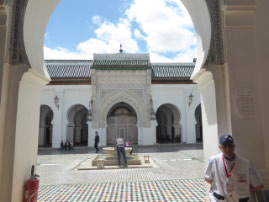
Kairaouine Mosque |
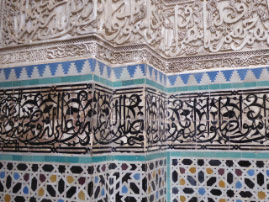
Kairaouine Mosque |
We continue to roam endlessly though twisty alleyways. Nour manages to carrel all but 5 of us and leads us to the restaurant (Restaurant Nejjarine) for lunch. Finally, the lost ones are found and returned to the fold for a big, tasty lunch – lentils, couscous, and giant chicken breasts – all under the lid of a steaming tagine.
Fat and happy, we next explore Cheez Alaoui, a tanning factory in operation since the 13th century. Piss and pigeon excrement are used in the tanning process making it very unpleasant for the guests, not to mention the employees. Each of us are given a big bunch of mint to hold to our noses to cut the smell – didn’t quite work. After the demonstration, we go to the enclosed, nicer smelling shops to purchase the leather goods. Bill buys a lovely, soft leather jacket – and I buy a purse made from goat leather. I really like my purse. It will accompany me for years to come. The sales people are a little aggressive, and also crazy and funny. I especially like the crazy part.
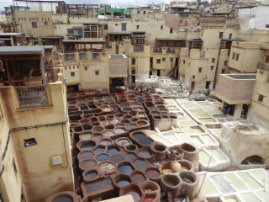
Cheez Alaoui |
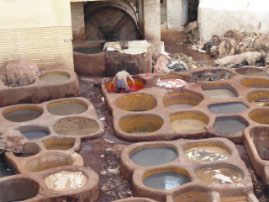
Cheez Alaoui |
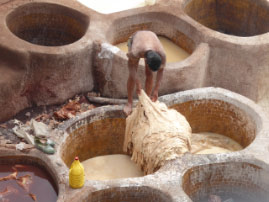
Cheez Alaoui |
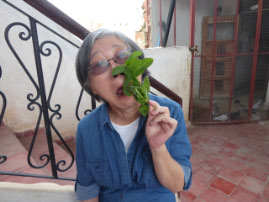
Cheez Alaoui |
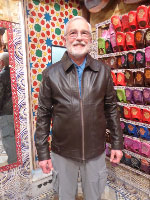
New Leather Jacket |
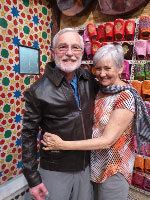
New Leather Jacket |
One final stop at the weaving factory (with many opportunities to buy) and then we are done with Fez. We walk back through the maze of shops (under Nour’s keen guidance) and back to the bus. Crazy, fun day!
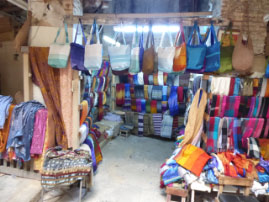
Weaving Factory |
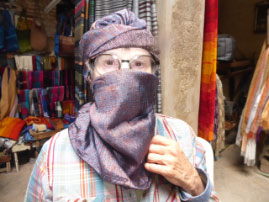
Weaving Factory |
Back at the riad, they are making big preparations for a wedding tonight. We watch the activities with others from the 3rd floor balcony.
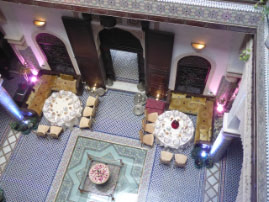
Wedding Preparations |
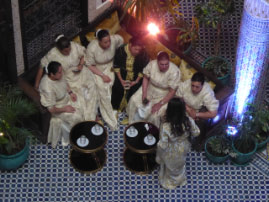
Wedding Preparations |
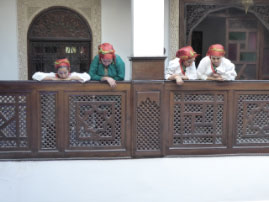
Wedding Preparations |
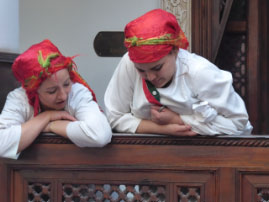
Wedding Preparations |
Later, we go with Bob, Joan and Jerri to a home hosted dinner. Sweet family – but oh so scary perfect. The daughter is in her 3rd year of college, studying to be a doctor. The son, a junior in high school, wants to be a pilot. A third daughter (not home that night) is studying to become an economist. The mom works for the City Hall in the HR department and the dad is a waiter. The dinner, lamb tagine, is very tough and fatty and stringy … but the food really didn’t matter. We enjoy our conversation until Joan asks if they believe in evolution. That is a show stopper – blasphemy even to bring up the word “evolution.” The mom runs off to make some tea while we watch a family wedding video. It was a disturbing video to me because the bride appears to despise the groom – kinda like Melania with Donald. We end the evening on a lovely note when we try on the mom’s fancy clothes.
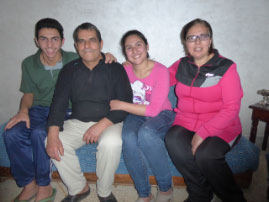
Home hosted dinner |
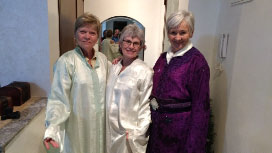
Home hosted dinner |
Back at the hotel, the wedding is in full swing. The bridal party insists we join them so we did. Amazing how much fun one can have dancing without any alcohol. In no time we felt like family. (Pictures below aren’t very good because I can’t dance and photograph at the same time.) We end our evening enjoying some wine on the 3rd floor patio overlooking the city. Great place!
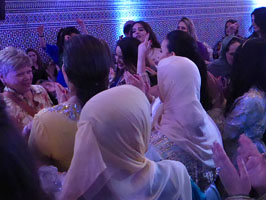
Celebrating at the Wedding |
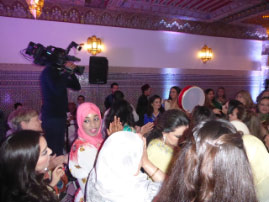
Celebrating at the Wedding |
Sunday, April 30 – Fez – Tours to Volubilis and Meknes
About 40 miles outside of Fez is Volubilis, a Roman Ruin. The drive is beautiful – very little development through the rolling farm lands. It’s so nice to get out of the city and see the countryside with the occasional sheep, donkeys and cattle. Although Volubilis is in the mountainous region of Morocco, the ruin is located on flat green plains and easy to spot from the road.
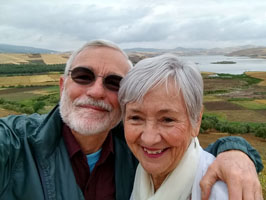
Road to Volubilis |
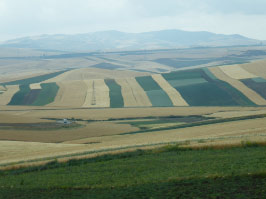
Road to Volubilis |
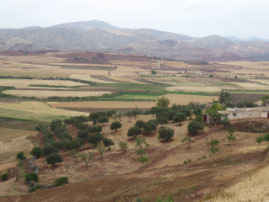
Road to Volubilis |
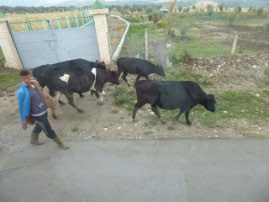
Road to Volubilis |
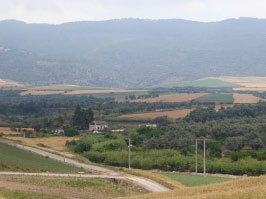
Road to Volubilis |
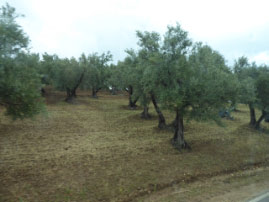
Road to Volubilis |
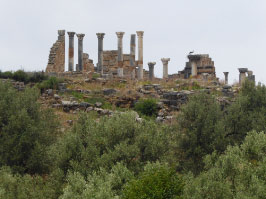
Volubilis |
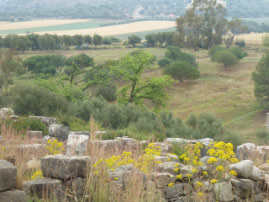
Volubilis |
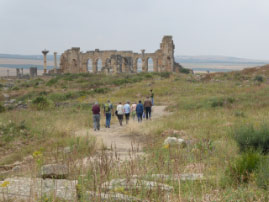
Volubilis |
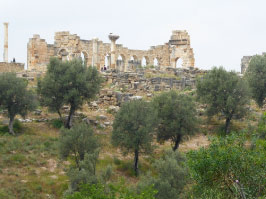
Volubilis |
We meet our guide, a very interesting fellow with lots to tell us. Volubilis means “morning glory.” We see a few scattered vines of morning glories interwoven in the ruins. The Ruins of Volubilis, a UNESCO World Heritage Site, became famous abroad when Martin Scorsese used it as a main location for his film, “The Last Temptation of Christ.”
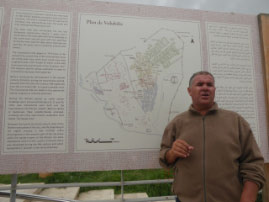
Volubilis |
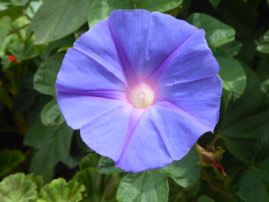
Volubilis |
Originally, Volubilis was a Carthaginian site settled in the third century B.C. However, in the 1st century AD, the Roman Empire took over and greatly expanded it, transforming it into one of its administrative centers, complete with mansions to house the Roman officials, a town center, a market place, a triumphal arc, the basilica, courthouse, bathes, aqua ducts and temples devoted to the Roman gods. At its peak, over 20,000 people lived in this area. The tile reliefs and stone work are just incredible.
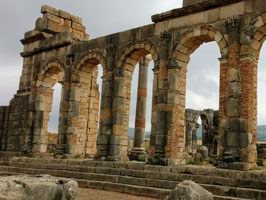
Volubilis |
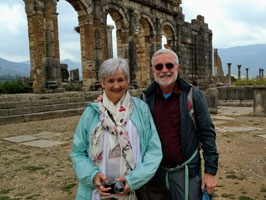
Volubilis |
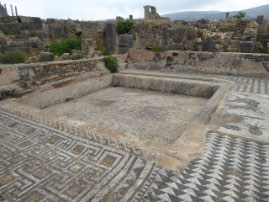
Volubilis |
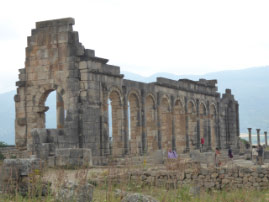
Volubilis |
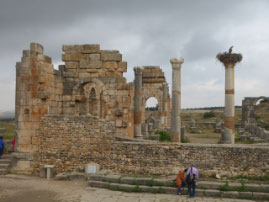
Volubilis |

Volubilis |
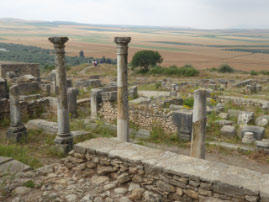
Volubilis |
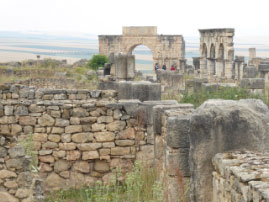
Volubilis |
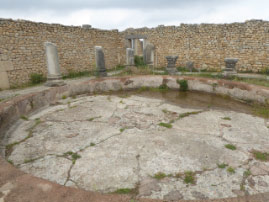
Volubilis |
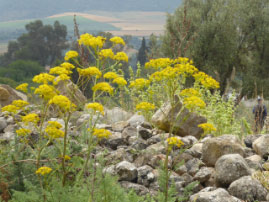
Volubilis |
The most famous structures at Volubilis is the Triumphal Arch of Caracalla, built for the Roman Emperor upon his death in 217 AD.
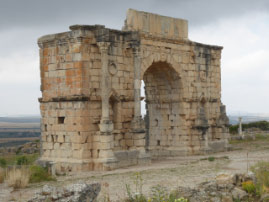
Volubilis |
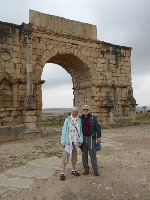
Volubilis |
The houses of the residents are also striking with beautifully decorated mosaic floors and colorful tiles depicting Roman mythology. The profits from exporting the crops (such as olive oils, grains, melons, grapes, figs, etc.) to Rome created a very wealthy upper class in this ancient city.
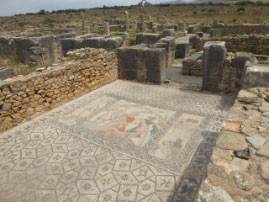
Volubilis |
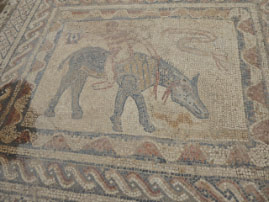
Volubilis |
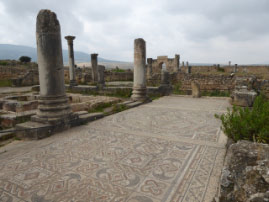
Volubilis |
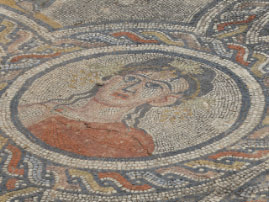
Volubilis |
Volubilis’ ruins are some of the best preserved in North Africa. Enough is still standing to appreciate how this ancient city would once have looked. However, the site has only been partially excavated. It’s sad to note that it would be impossible to return it to its original layout. Many of the stones used to build Volubilis were looted by later Moroccan rulers to build their own cities and magnificent palaces and landmarks. Much of it went to nearby city of Meknes for the huge construction projects.
I really like the vibe from the town and our guide is great at filling in the details. However, I sometimes prefer to walk alone by myself through these ruins and let my imagination reconstruct the city -- building up the lost walls and putting ceilings back on top of the ruins. I can almost hear the noises in my head of a busy market square, of people rushing through the streets, and of chants from the religious leaders.
This ancient city would have been a far and isolated outpost from the Roman Empire, not only across the sea, but many more miles inland. It would have been hard to protect the place from enemies. However, I think that many of the Romans sent to Volubilis would have liked their assignment. The fertile lands of this part of Morocco are beautiful and perfect for agriculture. It’s an exotic paradise and far from the political and military clashes that their peers back in Central Europe would have faced. I would have signed up in a heartbeat for Volubilis.
After exploring the ruins, we visit a small museum on the grounds that house artifacts taken from the site. I find it fascinating, but am annoyed by the gaggle of the loud, wild teenage school kids running through the museum. How is it possible to make such a disturbance?
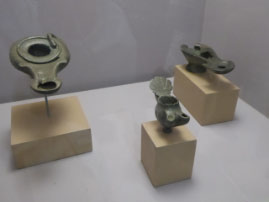
Volubilis |
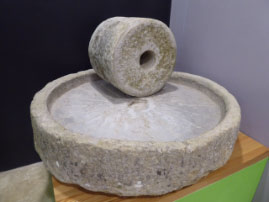
Volubilis |
We have a short drive to Meknes, once a royal city onetime home of the Moroccan Sultan Moulay Ismail (more about this dude later). We pass through the gates of the walled city and stop for lunch. We dine at a place named Princess Selma, who is married to the current king. Hundreds of photos of the King line the walls – some relaxed, casual photos with his family and some stilted official shots posing with dignitaries. I learn that the owner of the restaurant is good friends with the King. He runs a good restaurant. I especially like the beef tagine with prunes.
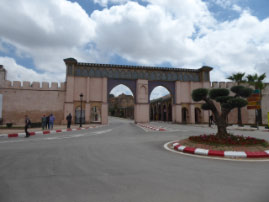
Meknes |
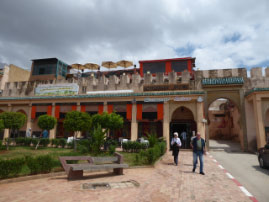
Meknes |
Next, we drive down the narrow ramparts and stop at one of the town’s five main gates. Our guide spends some time explaining that the neighborhood behind the gate was the Jewish section of town. Once 30,000 Jews lived there, but most of them left for Israel in 1948, leaving only about 10 families behind. We hear similar stories all over Morocco. Of course, I wonder did the Jews just up and leave, or were they chased out – my guess is the later.
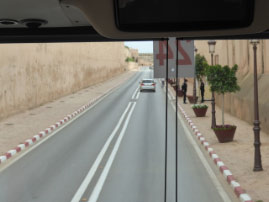
Drive down the narrow ramparts |
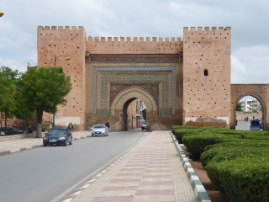
Gate to Jewish Quarter |
The next stops were massive granaries with mind boggling stables that once held over 12,000 horses -- all that was built in the 17th century by Sultan Moulay Ismail. I am fascinated by him – here’s some background information on him.
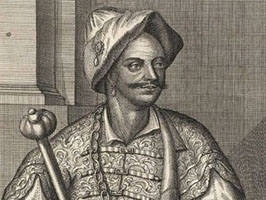
Moulay Ismail |
Sultan Moulay Ismaïl of Morocco, called "The Bloodthirsty," was born in 1645 and lived until 1727. He became the second ruler of the Moroccan Alaouite dynasty at age 27 and reigned for 55 years.
Moulay Ismail is one of the ‘greatest figures’ in Moroccan history. He inherited a country weakened by internal tribal wars and royal successions, but by the end of his reign, he controlled the country with a powerful army of more than 150,000 men.
He is infamous for his brutality and cruelty. He started his reign by displaying 400 heads at the city of Fez, and over the next 55 years it is estimated that he tortured and killed more than 30,000 people, not including those that died in battle.
Ismail was also fiercely protective of his four wives and 500 concubines. Men who merely looked at one of his wives or concubines were punished by death, and any suspicion of adultery against him was severely punished. The women were either strangled by the sultan himself, or their breasts were cut off, or their teeth torn out. The title of "The Bloodthirsty" fits him well.
He is also well-known for siring hundreds of children. According to the Guinness Book of World Records, Ismaïl fathered at least 888 children, and perhaps more than a 1,000.
When he wasn’t impregnating women – or ripping them apart, he was constructing his capital city and building walls and ramparts to keep out the enemies. To get into the city, one had to drive through four thick ramparts (4 meters thick) with huge doors. At least 25,000 slaves did the work for his numerous construction projects. Nobody knows how many slaves died during this period. |
Our guide told us Ismail was short and fat – but a genius at designing architectural masterpieces. (We are also fairly certain that his sperm count must have been very high.)
The bus drops us in front of a massive block of a building with a sign posted on the wall, loosely translated “The Granaries of Moulay Ismail.” We walk into Pandora’s Box, completely blown away by the series of immense arched halls. Many of the original beautifully carved doors are still in place and the arches, lighting fixtures, and hallways are fun to explore.
The large vaulted rooms were used to store the city’s grain supply, but more importantly to Ismail, to store hay and grain for the 12,000 horses housed in the royal stable just outside the building. According to one account, the granaries stored enough grain to feed the horses for twenty years!
To store such large amounts of grain, the granaries needed to be kept cool. Ingenious Ismail and his builders figured out an effective air conditioning system. The granaries were constructed with massive walls (23 feet wide), tiny windows, topped with a massive forest and gardens growing on the roof. Also, a system of underflow water channels forced through ducts in the floor kept the temperatures cool and the air circulating. The water came from a larger reservoir system that could not be destroyed or poisoned by the enemies.
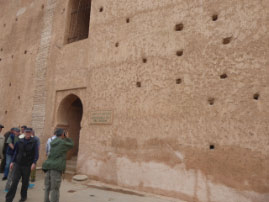
The Granaries of Moulay Ismail |
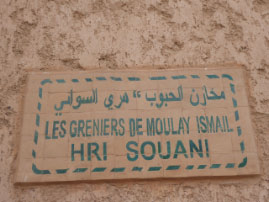
The Granaries of Moulay Ismail |
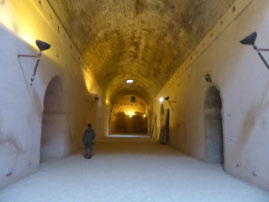
The Granaries of Moulay Ismail |
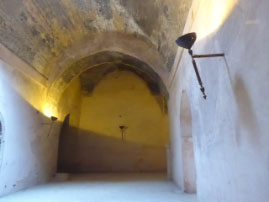
The Granaries of Moulay Ismail |
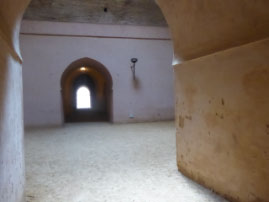
The Granaries of Moulay Ismail |
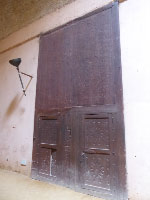
The Granaries of Moulay Ismail |
We exit the granary and enter directly into the royal stables, an amazing site. A series of mathematical placed arches create an optical illusion, making it appear that the arches go on and on forever – a fun place for a game of “hid and seek.”
The 1755 Lisbon earthquake left most of the stables in ruin. The roof was destroyed, but most of the arches were intact. The root system from the gardens and forest planted above the stable and granary, absorbed much of the earthquake shock and minimized the damage.
The massive stable yard was built to house 12,000 of the royal horses (Arab and Berber breeds). Ismail was fanatical about his horses. A groomer and a slave were assigned to each horse, to wait on them and make sure all their needs were met. Also the location of the stable was chosen to accommodate the horses. A canal running under the stables provides fresh water for the horses and the royal granary right next door gives easy access to their feed supply.
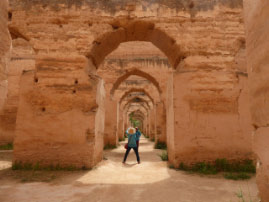
Royal Stables |
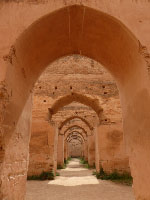
Royal Stables |
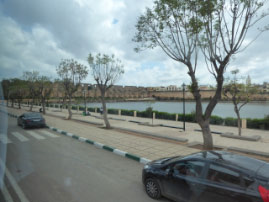
Road next to the Granary |
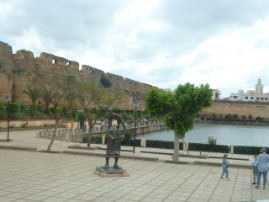
Road next to the Granary |
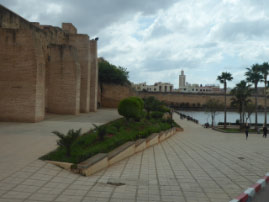
Road next to the Granary |
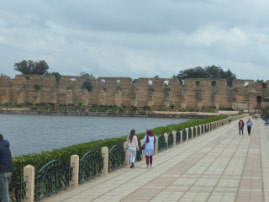
Road next to the Granary |
We drive by one of the many mosques. Nour tells us that all the minarets in Morocco are square, not rounded like the ones in Turkey from the Ottoman Empire. I did not see one rounded minaret during the entire trip and I was looking.
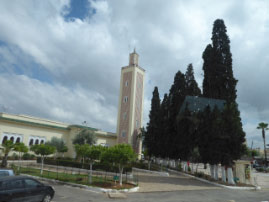
Square Minarets |
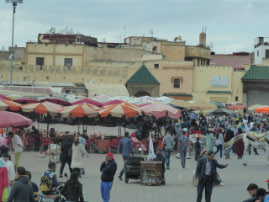
Meknes |
We drive to the heart of Meknes and park by a big marketplace (souks) which still maintains its medieval flare. Our guide leads us to the Bab Mansour Gate, right across from the market and carries on and on about the gate. It’s the largest gate in Morocco and the 2nd largest gate in all of Africa. Moulay Abdallah, son of Sultan Moulay Ismail, completed it in 1732 as the grand entrance to the Imperial City of Meknes. However, the Portuguese artisans came in to do the work. The height of main door is about 16m and the marble columns were looted from the Roman ruins of Volubilis – Shame on you! In spite of all the hype, I am “gated out” – seen enough gates. I’d rather be spending my time exploring the city.
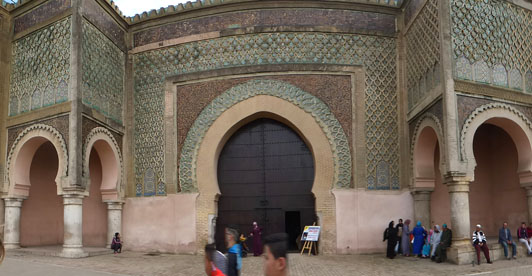
Grande Entrance to Meknes |
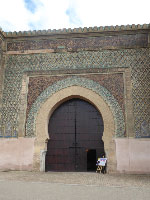
Grande Entrance |
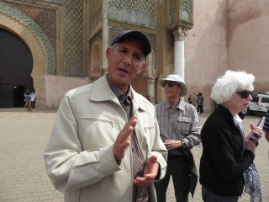
Meknes |
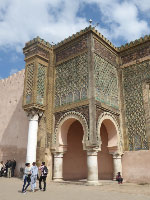
Meknes |
We return to Fez and explore the French-influenced Ville Nouvelle district down Hassan II Ave. Really looks like any boulevard in a French city. We stop at a super market for cheese, bread and fruit for a makeshift light dinner to share with our traveling pals. We bring our goodies and pig out on the rooftop outside Rex and Katy’s room. I go crazy over the cheese – especially the goat cheese, a specialty here. Think I over did it – will probably blocked me up for days! ;
Monday, May 1 – Fez to Erfond, gateway to the Sahara Desert
The staff at our hotel, the Riad Salam, give us a grand send off. They serve us a special breakfast and then give all the gals a scarf and all the guys a red top hat that Moroccans wear.
The hat, worn mostly in ceremonies and special events, is named the “Fez,” just like the city. Fez Medina was once the only place where Fez hats were made. Historically, the Fez hats were exclusively hand made by talented craftsmen, locally known as “Trabshi.” The hats have become a symbol of the kingdom, representing official dress. Now they are produced in many places, including Turkey and France, but the best quality hats are still those coming from Fez. The hats the guys got looked like they were made in China!
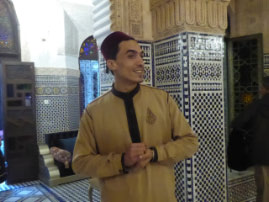
Fez hats |
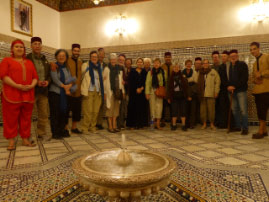
"Goodbye" Fez |
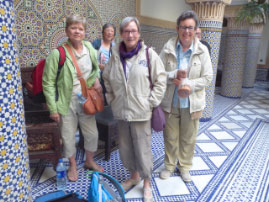
"Goodbye" Fez |
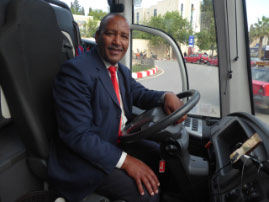
On the road again |
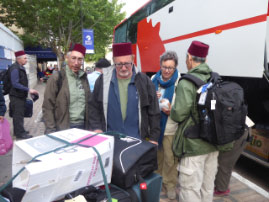
Fez Hats |
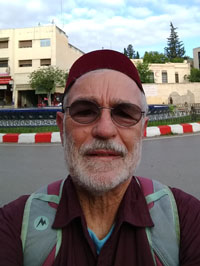
Bill's new hat |
We drive across the Middle Atlas mountain range, winding through beautiful pine groves and giant cedar forests. The contrast of the rich purple soil and the tall evergreens is magnificent.
After about an hour on the road, we stop at Ifrane for a coffee and a potty break. Ifrane (altitude of 5,460 feet) is often called ‘Africa’s Little Switzerland.’ Built by the French in the 1930s, it is reminiscent of a mountain resort in the Swiss Alps. With its Swiss chalet-like architecture, neatly trimmed lawns and gardens, tree-lined lake, and clean, crisp mountain air, you really feel as if you’re in a European sky resort – you even pay ridiculous prices for a cup of coffee. A lion statue similar to one in the Swiss city of Lucerne greets you at the entrance of the town. The village is home to a royal palace (the King likes to come here to ski) and a U.S.-curriculum university.
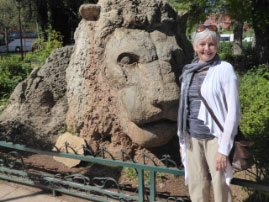
Ifrane |
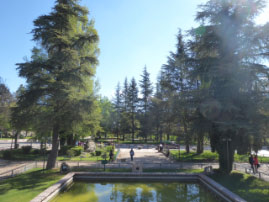
Ifrane |
We cross a 6,000 foot pass in the mountains and head further toward the Sahara, traveling through some fascinating and varied geologic and ecological zones.
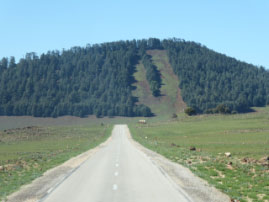
Atlas mountains |
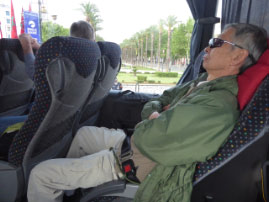
Atlas mountains |
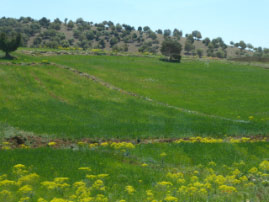
Atlas mountains |
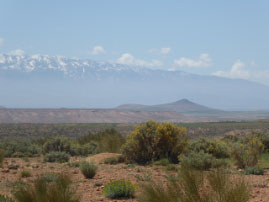
Atlas mountains |
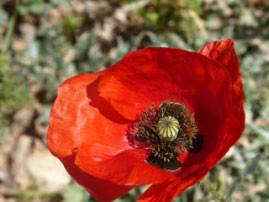
Atlas mountains |
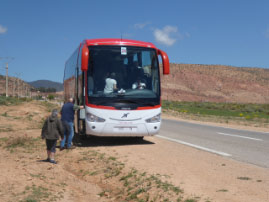
Atlas mountains |
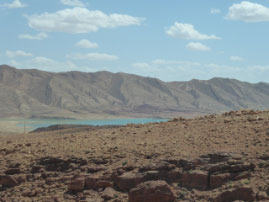
Atlas mountains |
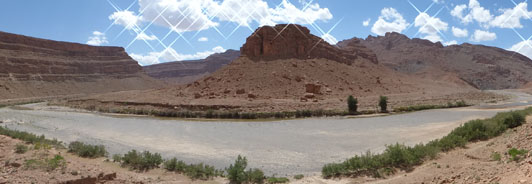
Atlas mountains |
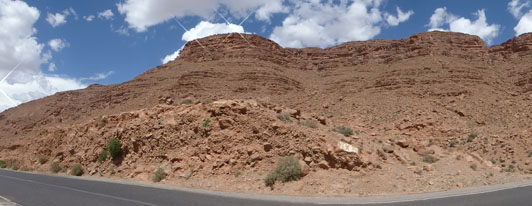
Atlas mountains |
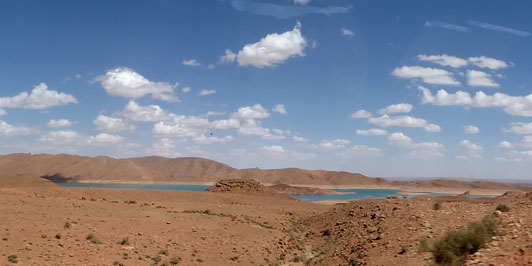
Atlas mountains |
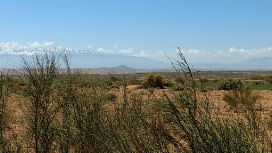
Atlas mountains |
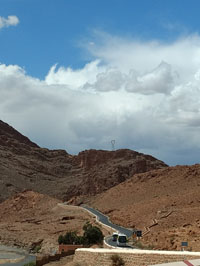
Atlas mountains |
Later we stop for lunch at a place in Midelt and walk to an overview of a Berber town below. (There is some significance to this town, which escapes me now. Can anyone help me out?)
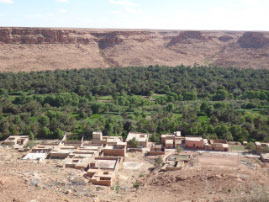
Atlas mountains |

Atlas mountains |
In the late afternoon, we descend into Erfoun, a small trading village that is the gateway to the Sahara Desert. Our hotel, Chergui Kasbah, is a wonderful desert oasis. We love the place and the balmy desert air.
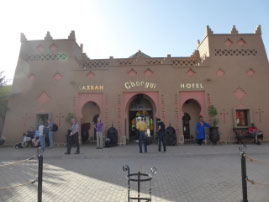
Erfoun |
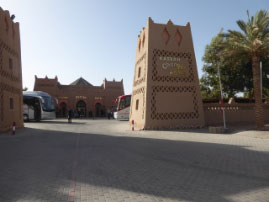
Erfoun |
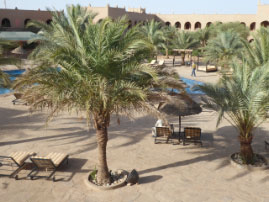
Erfoun |
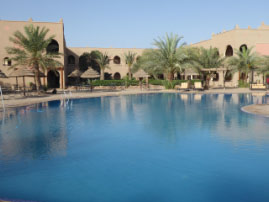
Erfoun |
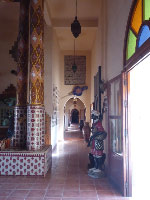
Erfoun |
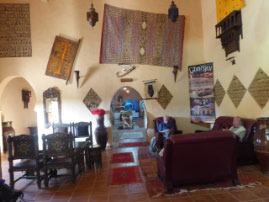
Erfoun |
We spend the rest of the afternoon at the pool drinking wine and relaxing with some of our travel mates. At 7:30 p.m., the hotel puts out a lovely buffet with an amazing variety of food. However, I am drawn to the pasta and pizza tables – nice having a little comfort food.
We go back to the room to reorganize our suitcases and prepare for the desert camp. It turned out to be very complicated process – figuring out what to take and what to leave and how to condense our stuff into one little suitcase.
Tuesday, May 2 – Off-Road and overland to the Sahara Desert Camp
After an early breakfast, we board our rugged 4X4 vehicles. We’re happy we get to share our 4X4 with Bob and Joan.
Before we head for the desert, we stop in town (Erfoud) to get some dirhams (AKA money) and then stop at a fascinating rock store.
Even for a non-rock lover like me, “Fossils of Erfoud” fascinates me. Posters on the wall depict some of the prehistoric creatures from this area and give me a quick lesson in geology all the while telling me what this shop is all about. These little critters and others like them lived some 350 million years ago in a shallow sea that covered the Sahara Desert. The shells of the creatures accumulated on the sea floor and were buried by sediments. Over the ages, they were fossilized (think that a proper term) and transformed into stone. That stone is Devonian black fossiliferous limestone and is seen all over the world in countertops and sculptures. It is in this factory where the fossilized slabs are cut, polished and made into countertops, furniture, platters, etc. We see the rough quarried slabs arrive and then the craftsmen turn them into treasures that give us a rare glimpse of ancient life on earth – and a chance to buy a piece of something that lived eons ago.
Of course, we exit through the Gift Shop, but not before buying Amy and Brian a cool platter and Zion a fossilized Desert Rose or sand rose that come only from this region.
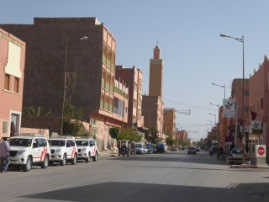
Erfoun |
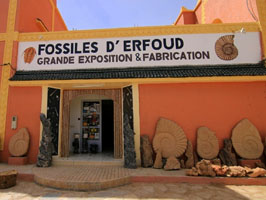
Fossile Shop in Erfoun |
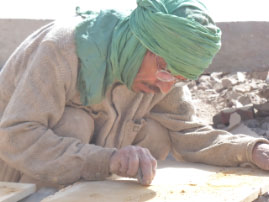
Fossile Shop in Erfoun |
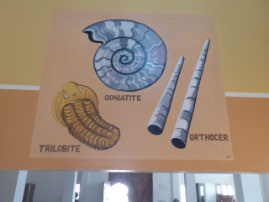
Fossile Shop in Erfoun |
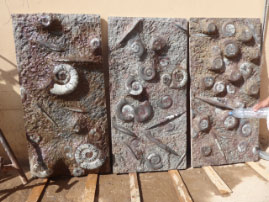
Fossile Shop in Erfoun |
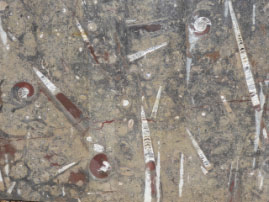
Fossile Shop in Erfoun |
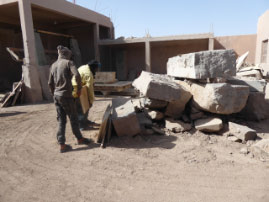
Fossile Shop in Erfoun |
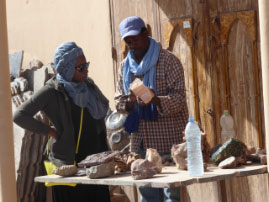
Fossile Shop in Erfoun |
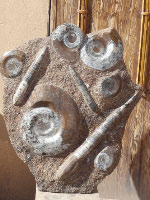
Fossile Shop in Erfoun |
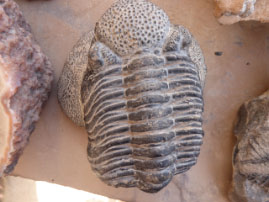
Fossile Shop in Erfoun |
Next we visit a Berber family in the village of Rissani. It’s a rugged environment. The village is constructed of mud that has endured for centuries and is surrounded by small clusters of gardens that struggle in the harsh, dry hot sun.
We wind our way through a narrow mud caked passage to the modest home. The mother, only 45, is worn down from her tough life. Her husband has a job pushing luggage carts from buses to nice hotels (like we know oh so well). They have 5 sons and one daughter. One of her sons (in his early 20’s) is mentally handicapped – a big challenge in their life. The daughter is married, no children, lives in another town, and teaches English. You can tell she brings great joy to her mother. The youngest son (age 11), is a handsome little guy. He goes to school, but was able to join us for tea. Nour said that he grew up in a Berber home just like this one. Each night, the family members roll out their mats and sleep together in the living room. He would get into trouble when he didn’t put his mat away in the morning. A large china cabinet, the nicest piece of furniture in the house, sits in the corner and stores the treasures passed down through the family. No one uses the coveted dishes or glassware – they just sit quietly, waiting to be passed down to the next generation.
The mother serves us tea while we attempt to chat with the 11 year old son. Later Marguerite models a ceremonial dress. A neighbor brings us fresh bread right out of an open fire oven. It is delicious. The bread was an extra treat to show us how honored they are that we came to visit. (These home visits are the reason we travel with OAT – You go away really knowing a place and connecting with the people.)
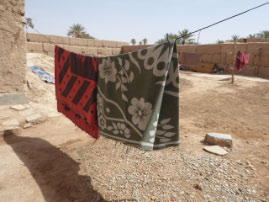
Berber Family |
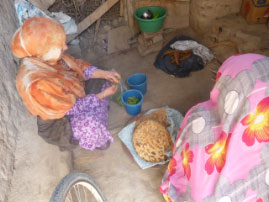
Berber Family |
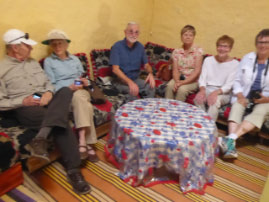
Berber Family |
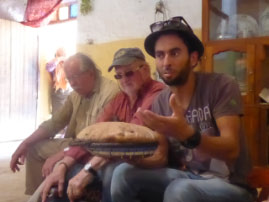
Berber Family |
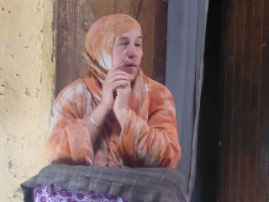
Berber Family |
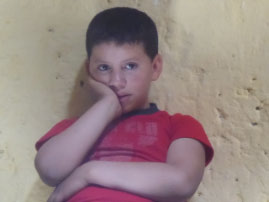
Berber Family |
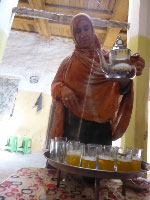
Berber Family |
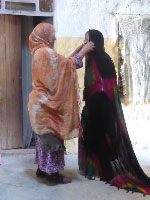
Berber Family |
Next, we head to the desert and our private tented campsite near Merzouga. There are no roads. It’s a real hoot watching our wild and crazy driver navigate the sandy tracks cutting through the dunes. I never knew that cutting across a desert could be so much fun. However, I’m sure the ride, full of bumps and sand dunes, isn’t good for Joan’s back. In spite of that, we did get into the spirit of racing with the other 4X4’s – Our driver is the fastest and the best!
For a week or so before we arrived, the worse sandstorm in years was raging in the desert. Thank goodness it settled down and just in time for our arrival. I love the peaceful desert. (I once was in a mild sandstorm in Jordan and thought I’d lose my mind!)
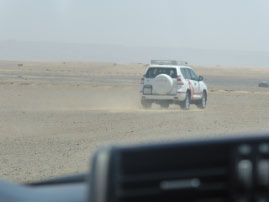
Sahara Desert |
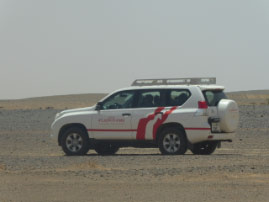
Sahara Desert |
We arrive at our campsite in time for lunch (if memory serves me). Ismail, our waiter, gives us a warm welcome and a cool welcoming drink. He’s charming and fun loving – I’m crazy about these Berger boys.
The dining room is hot – not a breeze to be found, but the beer does help -- the beer we bought in the liquor store in Rabat. We go our tents and I manage to get in a little nap – always good for the spirits.
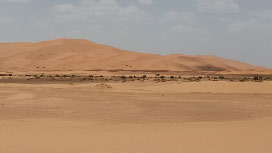
Sahara Desert |
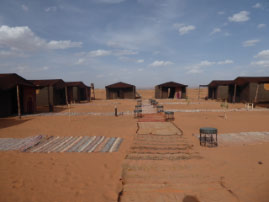
Sahara Desert |
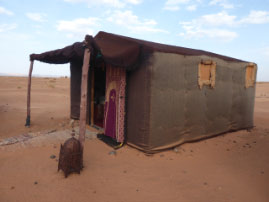
Sahara Desert |
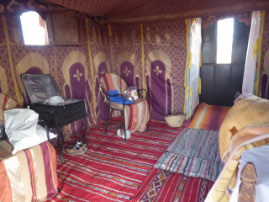
Sahara Desert |
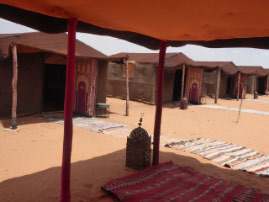
Sahara Desert |
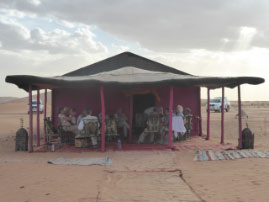
Sahara Desert |
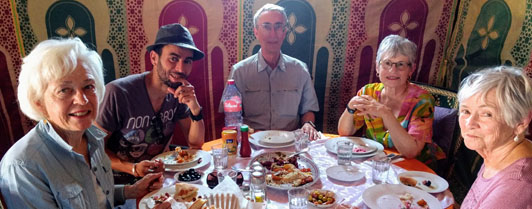
Sahara Desert |
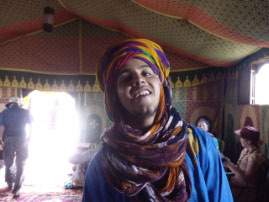
Sahara Desert |
Later in the afternoon, after it gets cooler, we hop in our 4X4’s to visit a nomadic family. The grandpa, or head of the clan, is a fun loving chap who embraces life and adores his family. He’s full and energy but claims he’s getting old (early 70’s) and thinking about retiring – whatever that looks like out here in the desert. He jokes with Nour and serves us tea in the tent. The family stays in the tent during warm weather and retreats to the mud house when it gets colder. I’m not sure of his occupation. He says he has a lot of land – but laughs about how he acquired it. (Wish I knew the full story.) He does own a herd of camels and assorted animals. I don’t think he could possibly grow anything in this area. His grandson is adorable and spends most of his day with his grandpa. He doesn’t go to school because there are none in the area. Instead of getting on my soapbox about not educating children, I realize that perhaps hanging out with this grandpa is probably as good an education than going to some of our schools in U.S. This is their way of life. They embrace their land and their family – and I embrace them!
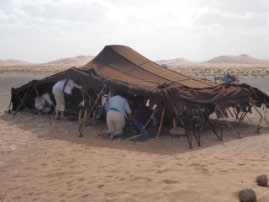
Nomad Family |
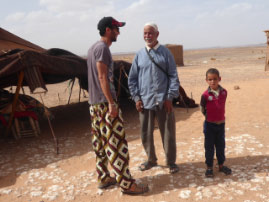
Sahara Desert |
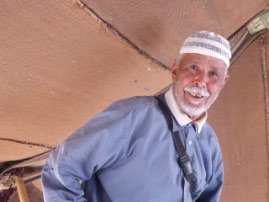
Nomad Family |
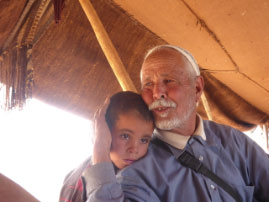
Nomad Family |
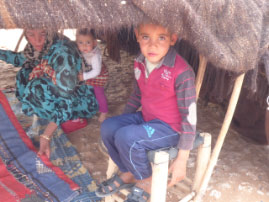
Nomad Family |
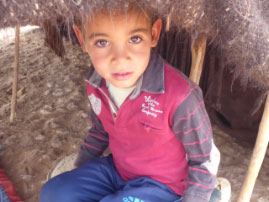
Nomad Family |
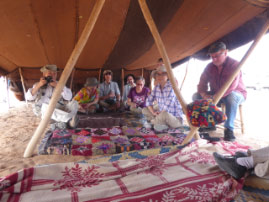
Nomad Family |
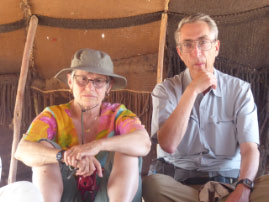
Bob and Joan |
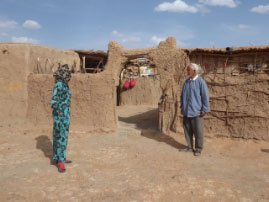
Nomad Family |
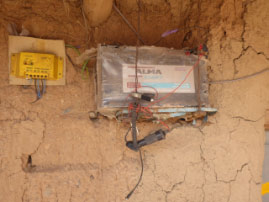
Nomad Family |
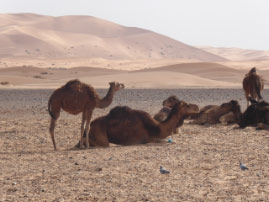
Nomad Family |
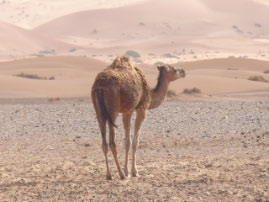
Nomad Family |
We arrive back at the camp for a little “Happy Hour” and a cooking lesson. One of the staff shows how to prepare chicken and vegetable tagine. She makes it looks so easy. We have it later for dinner – delicious!
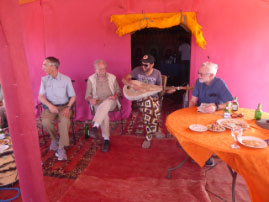
Sahara Desert |
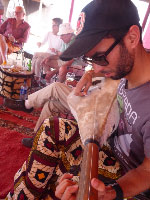
Sahara Desert |
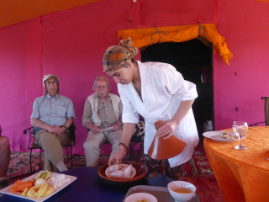
Sahara Desert |
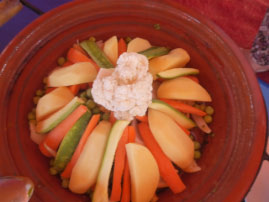
Sahara Desert |
The desert takes on a whole different aura at twilight. The glowing sea of sand dunes by our camp is a magical playground. Like a child again, it’s fun to jump from dune to dune of watch a bug scurry across the sand, headed for home. I love the quietness and wonderment of the place. We walk back to our tents under a starry sky. The quietness, calmness of the place is a beautiful gift.
Under my desert induced peacefulness, Bill and I enter our tent for the evening. A bat immediately dive bombs me and I hit the ground, screaming. Bill quickly leaves the tent and shoes the bat out into the desert night.
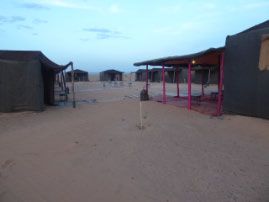
Sahara Desert |
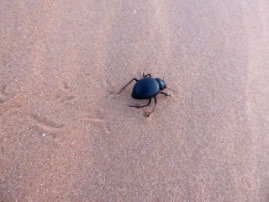
Sahara Desert |
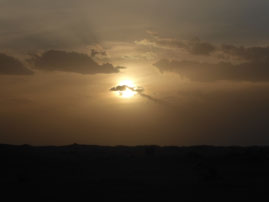
Sahara Desert |
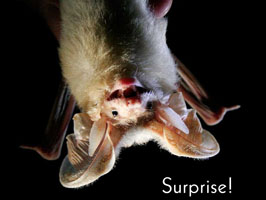
Sahara Desert |
We settle into our rustic tent (with an in suite bathroom). The fine Sahara sand shifts into our tent. I wait up several times during the night feeling the gritty sand lodged between my teeth – Don’t you love it? I savor the moments and think to myself that I wouldn’t be anywhere else but here!
|











